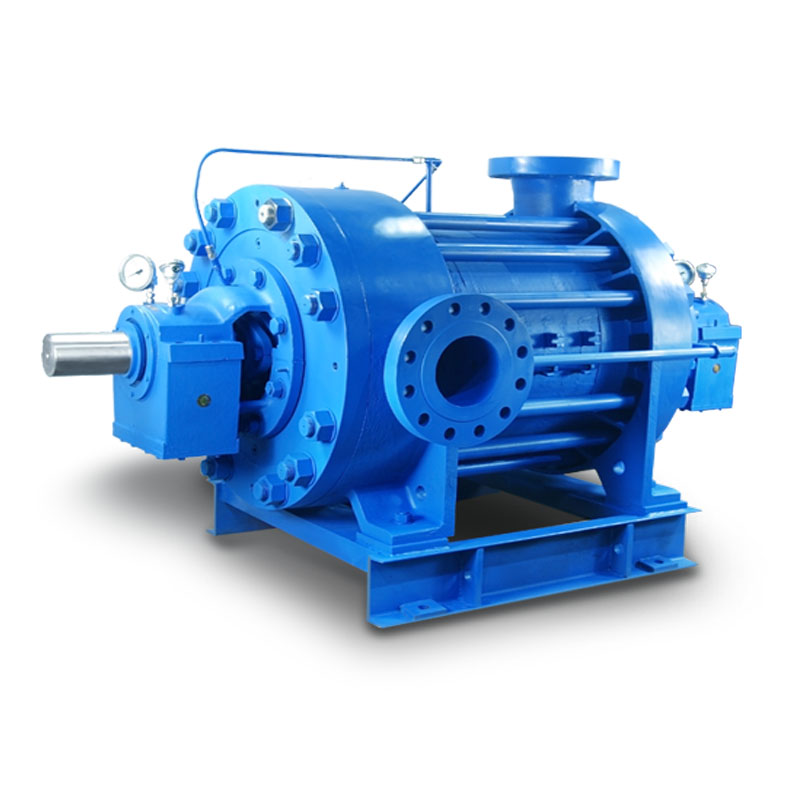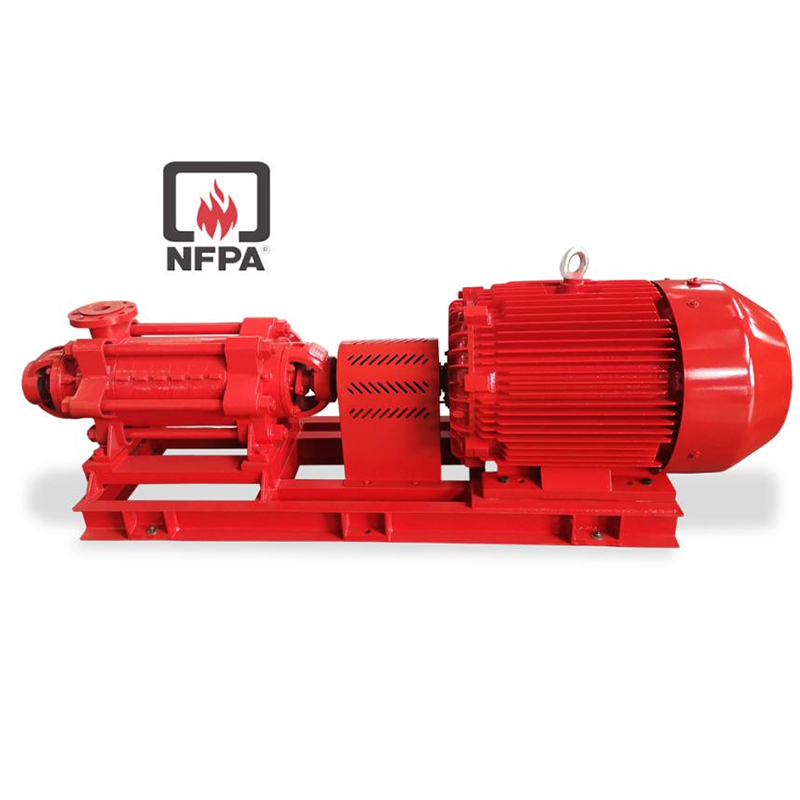What is a Multistage Centrifugal Pump?
A multistage centrifugal pump is a type of pump designed to move fluids with high efficiency and increased pressure. It consists of multiple impellers arranged in a series, each contributing to the total pressure generated. The pump is primarily used in systems requiring high head—meaning the pump needs to lift the fluid to considerable heights or transport it through long distances. These pumps are often seen in industrial applications where a significant amount of energy is needed to overcome pressure losses or lift fluid against gravity.
Each impeller, or stage, in the multistage pump functions in tandem, with each succeeding stage building on the pressure created by the previous one. As the fluid moves through each impeller, its velocity increases, leading to an overall rise in pressure by the time the fluid exits the pump. This mechanism makes multistage centrifugal pumps ideal for applications where a single-stage pump cannot provide the required head.
Applications of Multistage Pumps in Industry
The importance of multistage centrifugal pumps cannot be overstated, especially in industries such as water treatment, chemical processing, power generation, and oil & gas. These pumps are particularly valued for their ability to maintain high efficiency over long operational periods and demanding conditions. In water treatment plants, multistage pumps are used to pressurize water to reach different levels of filtration or to transport water over long distances to consumers. In the oil and gas sector, they are crucial for transporting crude oil, natural gas, and refined products through pipelines or between processing plants.
Furthermore, their versatility extends to applications where the pumping system must maintain a steady flow despite variations in demand. Multistage pumps are found in fire suppression systems, HVAC systems, and even in large-scale irrigation projects. Their adaptability makes them indispensable across many industries that rely on efficient, high-pressure fluid handling.
Basic Working Principle of Centrifugal Pumps
The Role of Centrifugal Force in Fluid Movement
At the heart of every centrifugal pump is the centrifugal force generated by the impeller. When fluid enters the pump, it is directed to the center of the impeller. The impeller blades rotate, causing the fluid to be thrown outward through the impeller’s circumference. This action accelerates the fluid and converts mechanical energy into kinetic energy, creating a pressure increase. The centrifugal force essentially forces the fluid away from the center, which leads to the creation of high-pressure zones at the outer edges of the pump.
This pressure difference causes the fluid to flow from the low-pressure inlet side to the high-pressure outlet side, allowing for continuous movement of the fluid. The efficiency of this transfer depends on factors like impeller speed, the design of the pump housing, and the type of fluid being pumped.
Key Components of a Centrifugal Pump
A centrifugal pump typically consists of several key components that work in unison to ensure optimal performance. These include:
- Impeller: The rotating component responsible for imparting kinetic energy to the fluid.
- Casing: The outer shell that surrounds the impeller, directing the flow of fluid through the pump.
- Suction and Discharge Nozzles: The inlet and outlet where fluid enters and exits the pump.
- Shaft: A mechanical linkage that connects the impeller to the motor, transferring rotational energy.
- Bearings and Seals: Components that reduce friction and prevent leakage, ensuring smooth and efficient operation.
Together, these components work harmoniously to ensure the continuous movement of fluid while minimizing energy loss.
How Fluid is Accelerated and Directed within the Pump
As the impeller rotates, it imparts kinetic energy to the fluid. The casing of the pump is designed to convert this kinetic energy into pressure energy. The fluid moves radially outward through the volute (or diffuser), which gradually reduces the velocity of the fluid while increasing its pressure. The fluid then exits the pump at high pressure, ready for delivery to the next part of the system. This transformation from kinetic energy to pressure energy is what makes centrifugal pumps highly effective for fluid transportation over varying distances and heights.
Multistage Design: How It Differs from Single-Stage Pumps
Benefits of Using Multiple Stages in Pumping Systems
The primary benefit of multistage pumps lies in their ability to generate higher pressures, which is essential for applications where fluid needs to be moved over long distances or to higher elevations. By utilizing multiple stages, these pumps distribute the pressure increase across several stages, reducing the strain on any single impeller and improving the overall efficiency of the system.
Additionally, multistage pumps tend to be more compact and cost-effective than using multiple single-stage pumps in parallel. They also provide smoother operation since each impeller operates within an optimal pressure range, minimizing mechanical wear and tear.
Common Industries that Rely on Multistage Pumps
Multistage centrifugal pumps are indispensable in a variety of industries. In the water and wastewater treatment industry, they are used for boosting water pressure and in reverse osmosis filtration systems. In oil and gas, they serve in both upstream and downstream applications, from pumping crude oil to delivering refined products to storage facilities. Other key industries that rely on multistage pumps include pharmaceuticals, food processing, mining, and fire protection systems.
Understanding the Pumping Process in Multistage Pumps
Water or Fluid Entry and Initial Impulse in the First Stage
The process begins when fluid enters the pump through the suction nozzle. In the first stage, the impeller receives the fluid and begins to impart velocity to it. The centrifugal force pushes the fluid outward, where it is directed toward the pump casing. The casing then channels the fluid towards the next impeller, where the pressure begins to build.
The Role of Each Stage in Building Pressure
As the fluid passes through each stage, the pressure continues to increase. The first impeller may only add a small amount of pressure, but subsequent impellers contribute progressively higher levels of pressure. By the time the fluid reaches the final stage, it has been pressurized to the required level, ready for discharge.
The exact number of stages required depends on the system’s specific needs. For example, if a system requires a head of 200 feet, a two-stage pump might generate 100 feet of head per stage, while a four-stage pump would generate 50 feet per stage, distributing the load more efficiently.
How Pressure is Delivered to the System
Once the fluid has passed through the final impeller, it exits the pump at the desired pressure and flow rate. The discharge nozzle directs the fluid into the system, which could include pipelines, storage tanks, or any other component requiring pressurized fluid. The entire process ensures that the fluid is transported with minimal energy loss and consistent pressure.
Factors Influencing Multistage Centrifugal Pump Performance
Several external factors can influence the performance of a multistage centrifugal pump. For instance, the speed of the impeller impacts the kinetic energy imparted to the fluid, thus affecting both flow and pressure. Fluid viscosity plays a crucial role as thicker fluids require more energy to move, which can reduce pump efficiency. Additionally, temperature changes can alter fluid properties, leading to variations in pump performance, especially when dealing with temperature-sensitive substances.
When to Choose a Multistage Centrifugal Pump
Choosing the right multistage centrifugal pump involves considering factors such as the required head, flow rate, and fluid characteristics. Additionally, the application’s specific requirements, such as energy efficiency, space constraints, and durability, should be evaluated. When high-pressure delivery is required, especially in systems with high lift or long-distance transportation needs, a multistage centrifugal pump is often the ideal choice.
Vertical vs Horizontal Multistage Pumps
Importance of Choosing the Right Configuration
Choosing between a vertical or horizontal multistage pump is not simply a matter of preference; it is a crucial decision that impacts the overall efficiency, lifespan, and cost-effectiveness of the pumping system. The correct choice depends on a multitude of factors, including the space available for installation, the required pressure and flow rates, and the type of fluid being pumped. Understanding the design differences and application scenarios of each pump type is key to making the right decision.
Design Differences Between Vertical and Horizontal Pumps
Construction and Layout of Vertical Multistage Pump
Vertical multistage pumps are designed with a vertical shaft that connects the motor to the pump impellers. The design usually consists of stacked stages that sit on top of each other, with the fluid being drawn into the pump from the bottom and discharged at the top. These pumps are typically compact and ideal for situations where height, rather than floor space, is a limiting factor. They are often mounted in wells, tanks, or other vertical spaces, utilizing the gravity force to aid in fluid intake.
The vertical design is especially useful for applications requiring high-pressure output, such as deep-well pumping or where the pump needs to handle significant vertical head. The structure is designed to maximize efficiency by providing a clear, straight path for the fluid to travel, minimizing energy losses.
Construction and Layout of Horizontal Multistage Pumps
In contrast, horizontal multistage pumps feature a horizontal shaft that connects the motor to the impellers. These pumps are typically wider and longer than vertical models, with the stages aligned side by side. Horizontal pumps generally have a more stable base and are easier to maintain due to their straightforward design. The layout ensures that fluid flows along a horizontal path, which is ideal for applications where the pump must handle large volumes or where a compact vertical arrangement is not feasible.
The horizontal design is typically employed in industrial environments where space is less of a concern, but the pump must accommodate higher flow rates or when the pump must be placed in a horizontal orientation due to system requirements.
Advantages and Disadvantages of Vertical Multistage Pumps
Benefits of Vertical Pumps
Vertical multistage pumps offer several distinct advantages. One of the primary benefits is their compact size. These pumps are ideal for locations with limited horizontal space, such as deep-well installations or areas where a smaller footprint is required. The design also reduces the amount of mechanical work needed to move fluids vertically, especially in deep systems.
Additionally, vertical pumps often require fewer foundations and less structural support compared to horizontal pumps, making them easier to install in certain applications. Their design allows them to efficiently manage high-pressure, high-head situations with minimal energy loss.
Benefits of Horizontal Pumps
Horizontal multistage pumps are known for their reliability and ease of maintenance. Their wide, stable base makes them less prone to issues related to weight distribution, which is a common concern with vertical pumps. The design of horizontal pumps also facilitates easy access to parts for routine inspections, maintenance, and repairs, reducing downtime and operational costs.
In terms of performance, horizontal pumps are highly effective in handling higher flow rates, making them ideal for applications in industrial environments where large volumes of fluid need to be transported over relatively short to medium distances.
Applications of Vertical vs Horizontal Multistage Pumps
Ideal Uses for Vertical Multistage Pumps
Vertical multistage pumps are most commonly used in applications where space is a premium and high-head performance is required. They are ideal for use in deep-well applications, where the pump must lift fluid from significant depths, such as in water supply systems, irrigation, and wastewater treatment plants. Additionally, vertical pumps are often employed in applications where the pump is placed inside confined vertical spaces, like tanks and shafts.
Ideal Uses for Horizontal Multistage Pumps
Horizontal multistage pumps are typically used in applications that involve high-flow, moderate to high-pressure systems. They are perfect for use in large industrial systems, such as chemical processing, fire protection systems, and large-scale water distribution. These pumps are also ideal for applications where ease of maintenance and a stable, accessible design are crucial considerations.
Post time: Feb-28-2025
 sales@tkflow.com
sales@tkflow.com 



